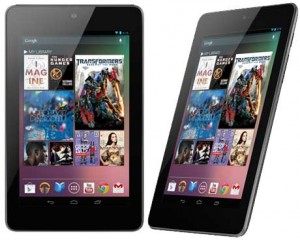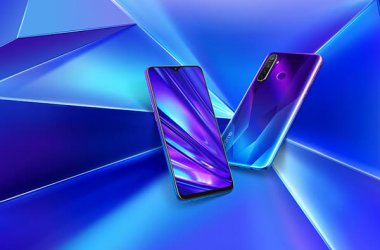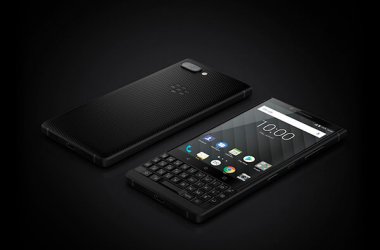 Google has announced its own-brand Nexus 7 tablet and we’ve managed to get some hands-on time with the much anticipated device.
Google has announced its own-brand Nexus 7 tablet and we’ve managed to get some hands-on time with the much anticipated device.
The Nexus 7 is available to pre-order now with a release date of mid-July and a price starting at just £159. The tablet will be the first device to ship with Android 4.1 Jelly Bean and is Google’s first attempt at an own-brand tablet.
Google Nexus 7: Design
As the name suggests the tablet has a 7in screen as is therefore a small tablet. It’s very comfortable in one hand, designed to be held in portrait mode predominantly. This is partly because it’s really light at 340g and respectably thin at 10.5mm.
The front is one piece of glass surrounded by a silver frame and a textured rear cover which has a rubbery feel. The finish on the rear cover provides a good amount of grip and feels nice to the touch.
Physical buttons and ports are minimal with a power button and volume rocker on the right hand side/rear while a microUSB port and headphone jack reside on the bottom of the tablet.
Google Nexus 7: Build quality
Most tablets we’ve seen with a price similar to the Nexus 7’s offer poor build quality. We found the build quality to be good but not flawless.
The device is made by Asus which makes good quality products but the Nexus 7 isn’t quite up there with things like the Zenbook. One thing we noticed was a slight gap between the non-removable rear cover and frame as you can see in the picture below. This may have just been our particular sample, though.
The other problem we found was rippling on the screen at the top and bottom edges. This is something we saw on the HTC One X and happened when putting pressure on the display. We’re not suggesting that everyone will be pushing the screen like it’s one giant physical button but it is more worrying in terms of traveling with the Nexus 7 in a bag, for example.
These are both minor quibbles and overall the Nexus 7 is a well-built piece of kit, especially when you consider its price.
Google Nexus 7: Hardware
The Nexus 7 has a surprisingly good line-up of hardware for a tablet with a budget price tag. For starters it uses the same nVidia Tegra 3 quad-core processor found in many high-end tablets. This is backed up by a healthy 1GB of RAM.
The highlight for us is the 7in screen which uses an in-plane switching (IPS) panel and has a resolution of 1280 x 800. The display has excellent contrast, brightness and viewing angles.The level of detail is high thanks to the 1280 x 800 resolution giving a pixel density of 216ppi. This is higher than the Samsung Galaxy Tab 2 (7.0) which costs more money.
Storage is limited at either 8GB or 16GB with the latter costing £199 compared to £159. Unfortunately a cost cutting measures mean there’s no microSD for expansion. This is probably the biggest let down about the Nexus 7. Asus told us there is less focus on local storage with content stored in the cloud. However, the Nexus 7 doesn’t have 3G capabilities.
There is 802.11b/g/n Wi-Fi so you can tether the Nexus 7 to a smartphone for data on-the-go. Other connectivity includes Bluetooth, GPS and a near-field communications (NFC) chip.
In an attempt to save costs there’s no rear facing camera present on the Nexus 7. This doesn’t bother us much seeing as smartphone cameras tend to be better and more suitable to use. There is a fairly decent 1.2Mp front facing camera for video chats, though.
Google Nexus 7: Software
The Nexus 7 brings with it the latest version of Android, this time it’s called 4.1 Jelly Bean, an incremental update to 4.0 Ice Cream Sandwich.
There’s no major overhaul on the interface so existing Android users will be immediately familiar with the layout and the way things work. However, Google has improved the performance and responsiveness of the operating system. In a word it’s slick, a polished and refined version of Ice Cream Sandwich and closes the gap between Android and iOS.
We experienced no lag whatsoever across the entire tablet whether we were moving around the home screens, menus or scrolling through a video. Web browsing also gave smooth performance from the pre-loaded Chrome browser which loaded pages fast and did bat an eyelid at pinch zooming and scrolling.
Nice enhancements have been made to notifications which expand to show more information and allow you to respond via action buttons without opening the associated app. Widgets now resize automatically to the space you place them into.
Dictation can now be used offline and there are a number of improvements and changes to Google search. Search results are displayed in information cards and you can use voice to ask questions and get answers back in an audible voice. We found it understood the vast majority of questions we asked and gave us an answer quickly.
Google Now is a feature which aims to predict what information you will need, such as directions or train times so you don’t actually need to search for it. It will gather what it thinks is useful information based on things like your location and events in your calendar. This feature requires time and the tablet needs information so we were unable to test in during our brief time with the Nexus 7.
The one issue we had with the software on the Nexus 7 was that the home screen interface does not support a landscape mode. The tablet is designed to be held in portrait orientation but we still would like the option to use it in landscape mode too, for example after watching a video.
Google Nexus 7: Battery life
Since we only had a short amount of time with the Nexus 7 we were unable to test battery life so stay tuned for the full review for our verdict. Google touts an iPad matching 10 hours of battery life while browsing the web over Wi-Fi. On paper this is impressive so we hope it lives up to this promise.
Our verdict:
We are very impressed with the Nexus 7 after our hands-on time with it. It’s hard to believe a nicely designed and well-build tablet with such an impressive specification has price as low as this. This combination means the Nexus 7 is set to be big winner. Look out for the full review to see if we still have this opinion after thorough testing.





